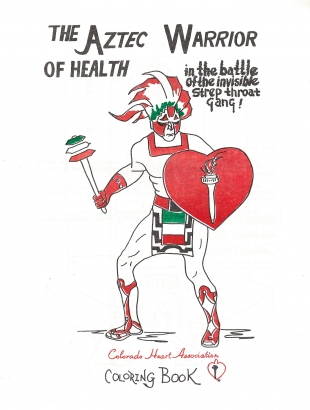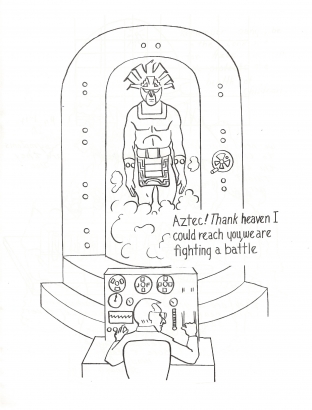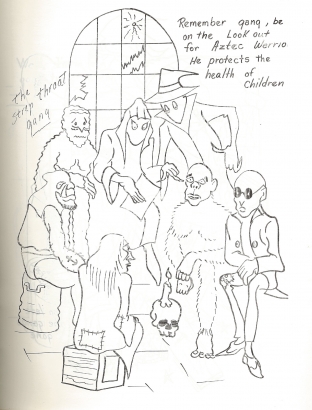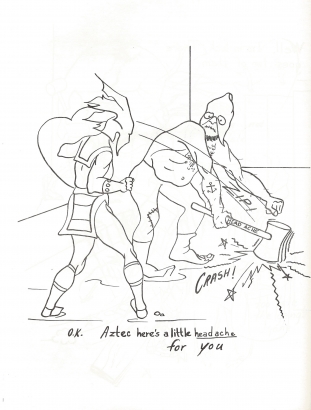There are monsters that lurk among us. Horrible, nearly invisible creatures that, if you are unfortunate enough to cross their path, will lay you low with a fever, sore throat and swollen glands.
These fiends are easily fought with a one-two punch, and yet legions of kids have succumbed to their clutches. The ghouls know no barriers of class or race, and left unaddressed can cause rheumatic fever, permanent heart damage and even death. These monsters are known as the Strep Throat Gang! And who is brave enough to fight them off? The Aztec Warrior of Health, that’s who!
Joking aside, strep throat is a highly dangerous yet manageable bacterial infection that can usually be quelled with a cycle of antibiotics. While symptoms often include swollen neck glands and a killer sore throat, those two signs aren’t always present. In the absence of medical examination, parents can sometimes assume their child has a different, less serious ailment.
So what does strep have to do with Aztec warriors? In 1972 or 1973, Denver's Westside Coalition paired up with the Colorado Heart Association and Denver-based artist John Flores to design a coloring book entitled The Aztec Warrior of Health in the Battle of the Invisible Strep Throat Gang. The book was part of a larger public health education campaign about the symptoms and dangers of strep, created for parents and kids on Denver’s West Side.
Best of all (especially from a kid’s perspective), the coloring book featured an Aztec Warrior—brought to the modern era via time machine—to fight a gang of unsavory-looking toughs known as the “Strep Throat Gang.” Each monster-like member of the gang represented a symptom of the disease and were each taken out in turn by the Warrior’s fisticuffs.
While fighting disease is a noble cause, one may wonder why the focus on this particular one. In the early 1970s, Denver schoolkids were experiencing frequent bouts of strep. In 1973 alone, the rate of positive culture tests dramatically increased from 10 percent statewide to between 18 and 20 percent. A large number of children with strep on Denver’s West Side were undiagnosed and untreated, due to varying factors ranging from the economic (the prohibitive costs of going to the doctor) to a lack of public awareness about the disease.
The Westside Coalition, a community activist organization committed to addressing needs in this historically underserved part of town, decided to tackle the health scourge with a public education campaign. Their project included everything from working with the Mariposa Health Clinic, which offered free throat cultures, to going door-to-door throughout the neighborhood to talk about strep. The Coalition presented at schools, hosted a Field Day and poster contest for kids, ran articles in the West Side Recorder newspaper, and by April 1974, had handed out more than 5,000 copies of the Aztec Warrior book.
As with all righteous superheroes—Pow! Crash!—the Aztec Warrior was victorious in his fight for health. The book closes with a lone remaining tough threatening: "Aztec may have won this time. But I’ll get me a new gang and before long we’ll be spreading strep throat again," and includes a final warning from our hero:
Remember kids, if any of the seven symptoms are bothering you, tell Mom and she will call the doctor….
Who knows what monsters lurk in the throats of man? Aztec Warrior knows, and in 1970s Denver, he and the Westside Coalition were determined to save kids from a curable illness. Take that, Strep Throat Gang!
---------------------------------------------------------
This coloring book is part of a much larger collection of Richard Castro’s papers, recently acquired by the Western History and Genealogy Department.
Richard Castro served for a decade in the Colorado House of Representatives, and as the head of Denver’s Agency for Human Rights and Community Relations under Mayor Federico Peña. In relation to this story, Castro also served as chairman of the Westside Coalition’s health committee and was involved with the anti-strep campaign.
Our archivists are currently arranging and cataloging this collection, which will be available for public research in 2020.





Add new comment